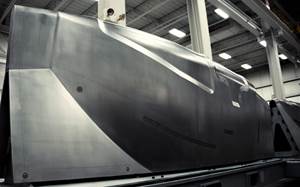Cocured materials damp vibration in composite structures
Viscoelastic layers convert strain energy into heat, suppressing the harmful effects.
Vibration occurs in any structure that moves or has moving parts. The effects of vibration range from minor annoyance, such as noise in an automobile, to significant damage to the structure or its contents. The simplest way to design around vibration problems is to make the structure more rugged so that it can withstand the vibration without damage. This approach, however, always adds weight to the structure and often cannot be applied to certain delicate instruments or other sensitive payloads. For example, while it is possible to build an electronics package that can survive the vibration environment of a space launch vehicle, designing a mirror that can withstand the same conditions is a much greater challenge.
An alternative approach is to suppress the vibration, reducing its magnitude and thereby minimizing its effects. CSA Engineering (CSA, Mountain View, Calif., U.S.A.) specializes in designing and building vibration suppression systems for aerospace and industrial applications. Conor Johnson, president of CSA and a principal engineer, explains that the company uses two main approaches to vibration suppression: isolation and damping. Neither completely eliminates vibration, but both reduce the vibration at frequencies where the structure is most susceptible to damage. Isolation is mainly used to counteract higher frequency vibrations. Special mounts are installed, which prevent the vibration from moving across certain parts of the structure, either isolating individual components, such as instruments, or isolating a vibration source, such as a motor or pump.
Damping systems do not isolate the structure from the vibration source, but instead reduce the magnitude of the vibration within the structure. Damping technologies can be divided further into two categories: passive and active (the same categories also apply to isolation technologies.) In passive systems, vibrations are diverted into special materials or structural components that dissipate the vibration energy as heat. In active systems, an electronic system monitors the response of the structure to vibration, and actuators then move the structure in opposition to the vibration, effectively canceling it out. Active systems can achieve greater performance and control than passive systems, but they are significantly more expensive, take up more space and require power.
Identifying vibration problems
Structures vibrate when an applied force varies with time. The cyclic force repeatedly peaks and drops off; the time between peaks is the frequency. Although the dynamic force may not follow a smooth curve with a simple frequency, most forces can be viewed as combinations of sinusoidal cyclic forces and different frequencies.
Likewise, the dynamics of a structure can be characterized by discrete resonant frequencies, or modes, each with its own unique shape. Structures react to the entire spectrum of applied force frequencies, but the response to the resonant components of the force will be amplified. Suppression systems lower the overall response, but most often the main goal is to remove the resonant peaks. Resonant responses can lead to many problems, including high dynamic stresses, excessive dynamic motions and early fatigue failures. Minimizing these effects enables the structure to be lighter. Vibration may cause a stationary object to move out of position or alignment, which would prevent certain instruments, such as optical systems, from operating properly at all.
"The first step in a design," says Johnson, "is to identify the modes you want to suppress." In most cases, that requires a special type of finite element analysis (FEA), called modal analysis. Joe Maly, an associate principal engineer, is one of CSA's expert analysts. He builds detailed finite element models using MSC.Nastran (MSC.Software, Santa Ana, Calif., U.S.A.), running on dual processor HP/Linux machines. Dynamic models typically require less detail than static stress models in order to accurately capture the modal shapes. Nevertheless, the models Maly creates range in size from several thousand to a few million degrees of freedom (DOF), and take anywhere from seconds to hours to run. The FE results show the vibrations as strain energy; identifying regions of high strain energy shows where vibration suppression methods should be applied.
Related Content
Plant tour: National Institute for Aviation Research, Wichita, Kan., U.S.
NIAR, located at Wichita State University in the heart of the American aerospace manufacturing industry, has evolved to become a premier hub of teaching, R&D, creativity and innovation.
Read MoreMaterials & Processes: Tooling for composites
Composite parts are formed in molds, also known as tools. Tools can be made from virtually any material. The material type, shape and complexity depend upon the part and length of production run. Here's a short summary of the issues involved in electing and making tools.
Read MoreJEC World 2022, Part 3: Emphasizing emerging markets, thermoplastics and carbon fiber
CW editor-in-chief Jeff Sloan identifies companies exhibiting at JEC World 2022 that are advancing both materials and technologies for the growing AAM, hydrogen, automotive and sustainability markets.
Read MoreNine factors to consider when designing composites cure tooling
Gary Bond discusses the common pitfalls and compromises when designing good cure tooling and their holistic significance for a robust composite production process.
Read MoreRead Next
Composites end markets: Energy (2024)
Composites are used widely in oil/gas, wind and other renewable energy applications. Despite market challenges, growth potential and innovation for composites continue.
Read MoreCW’s 2024 Top Shops survey offers new approach to benchmarking
Respondents that complete the survey by April 30, 2024, have the chance to be recognized as an honoree.
Read MoreFrom the CW Archives: The tale of the thermoplastic cryotank
In 2006, guest columnist Bob Hartunian related the story of his efforts two decades prior, while at McDonnell Douglas, to develop a thermoplastic composite crytank for hydrogen storage. He learned a lot of lessons.
Read More

























